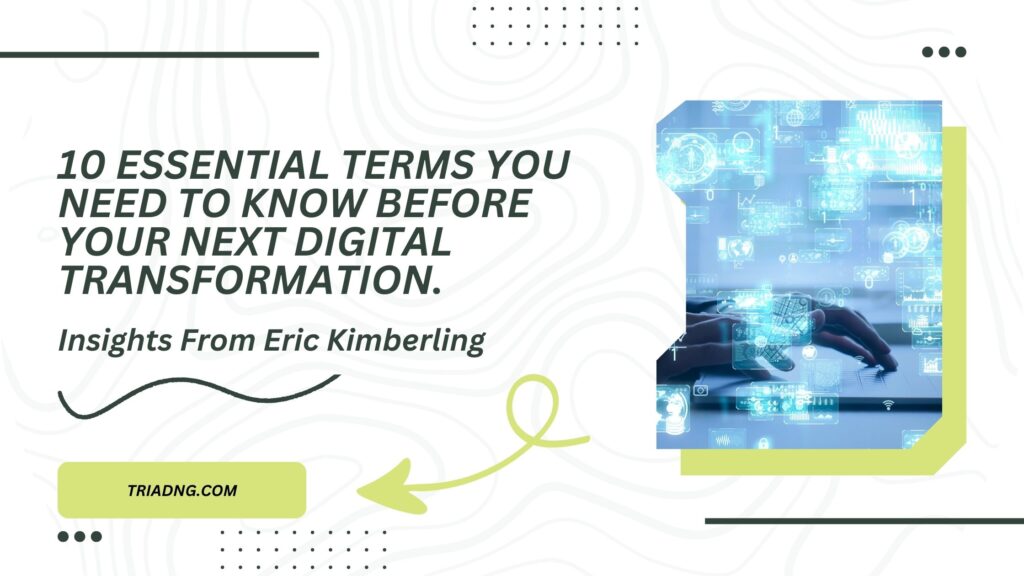10 Essential Terms You Need to Know Before Your Next Digital Transformation Insights From Eric Kimberling

Are you preparing to launch a digital transformation but feel like you’re learning a new language? With terms like ERP, agile, and project governance being used frequently, it’s easy to feel lost before you even begin. A successful transformation starts with a shared understanding, ensuring your entire team, from stakeholders to consultants is speaking the same language.
At TRIAD, we believe in empowering businesses to navigate the complexities of digital change with confidence. While understanding the vocabulary is a crucial first step, our expertise lies in turning that knowledge into action. We manage the technical details from implementing AI-driven automations to handling your digital marketing so you can focus on strategy.
Let’s break down the ten essential terms you need to know, inspired by an insightful breakdown from Eric Kimberling of Third Stage Consulting.
1. Core Enterprise Technologies (ERP, CRM, HCM, SCM)
Every business runs on technology, but the acronyms can be confusing. Here are the main types:
- ERP (Enterprise Resource Planning): Think of this as the central hub for your organization. ERP systems tie together core functions like financials, inventory management, and HR under a single umbrella.
- CRM (Customer Relationship Management): This is your tool for managing interactions with potential and current customers. It automates the sales pipeline, tracks team activities, and manages leads from the very first contact.
- HCM (Human Capital Management): This software handles all your HR processes, including payroll, benefits, performance reviews, and employee management.
- SCM (Supply Chain Management): SCM systems manage everything from ordering raw materials and manufacturing to warehousing and final distribution logistics.
2. On-Premise vs. Cloud
This distinction is all about where your technology lives.
- On-Premise: The software is installed and runs on servers located within your own physical office or facilities.
- Cloud: The software and your data are hosted off-site by a third-party provider. While many vendors are moving to the cloud, on-premise solutions are often more mature and established.
3. Configuration vs. Customization
Every technology deployment involves some level of setup.
- Configuration: You are personalizing the software for your needs within the existing framework. This involves choosing which screens to use and how information flows, all based on how the software was designed to be used.
- Customization: This takes it a step further by changing the software’s code to do something it wasn’t originally built to do. While sometimes necessary, customization often leads to higher costs, greater risk, and difficulties with future upgrades.
4. Business Requirements
This is the foundational definition of what you need your technology to accomplish. Business requirements are based on your ideal future state and unique processes. Defining these early is critical for selecting the right system and ensuring a successful implementation.
5. Organizational Change Management (OCM)
Often misunderstood as just communications and training, OCM is about managing the people side of a transformation. It addresses how roles and responsibilities will change, how new organizational structures will work, and the direct impact on your employees. According to Kimberling, failing to adequately address OCM is the number one reason why most transformations fail.
6. Project Governance
This is the framework you use to manage the project and make key decisions. It includes the project charter, roles and responsibilities, timelines, resource allocations, and how success will be measured. Strong project governance provides the controls needed to keep your transformation on track.
7. Agile vs. Waterfall Deployments
These are two different approaches to managing an implementation.
- Waterfall: A traditional, sequential method where you complete and sign off on each step (e.g., requirements, design, build) before moving to the next.
- Agile: A more iterative approach where you build and test technology in real-time, gathering immediate feedback to make adjustments. The goal is to deploy a minimum viable product quickly and pivot as needed.
8. Integration
In an age of multiple systems, integration is the way these different platforms talk to one another. It’s how data and workflows are transferred between systems—for example, ensuring that sales commission data from your CRM system flows seamlessly into your financial system.
9. Architecture
Architecture is the high-level map of your entire technology landscape. It’s often a visual representation showing all your different systems, where the integration points are, and how data flows between them throughout the organization.
10. Master Data
While regular data refers to daily transactions, master data is the core, overarching information used to run your business. Examples include your chart of accounts, product masters (information about everything you sell), and customer masters. This data is foundational to how your workflows and systems operate.
This was inspired by the insights shared in “Digital Transformation with Eric Kimberling.” You can watch the original video here.
Turning Knowledge Into Action with TRIAD
Understanding these ten terms is the first step toward a successful digital transformation. The next is flawless execution.
Knowing the difference between CRM and ERP is important, but leveraging AI-driven automations to make them communicate seamlessly is where true value is created. Recognizing the need for organizational change is one thing; supporting your team through it with our Executive Virtual Assistant Services and skills bootcamps is another.
At TRIAD, we handle the complexities of your digital ecosystem. We provide the framework and execution so you can stay focused on the strategy.
Ready to move from definition to results? Let’s connect.